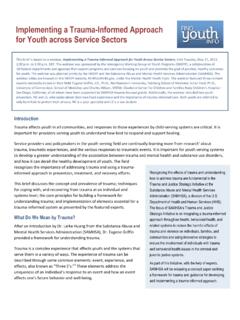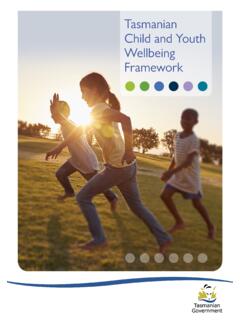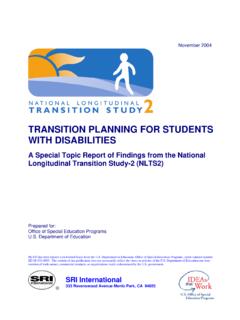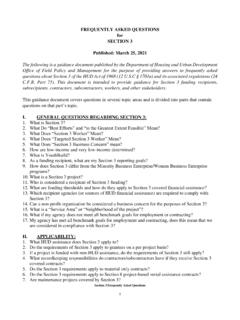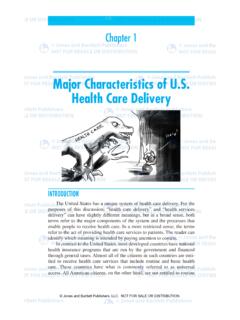Transcription of Identifying and Addressing Barriers to Program ... - Youth
1 PREPARED BY: Larry Pasti, The Forum for Youth Investment Tara Smith, JFF Identifying AND Addressing Barriers TO Program IMPLEMENTATION A TOOL FOR COMMUNITY REFLECTION BACKGROUND Helping to reconnect Youth back to education and employment and get them on a path to a successful transition to adulthood that includes economic self-sufficiency, skills that support independent living, and improved health, mental health and well-being can be challenging. Youth development stakeholders and beneficiaries ( , the Youth themselves) describe significant challenges that hinder meaningful improvements in education, employment, health, and well-being outcomes.
2 Such challenges include: poor coordination across the systems that serve Youth ; policies that make it hard to engage the most vulnerable Youth with services and resources to help them overcome personal Barriers ; fragmented data systems that inhibit the flow of information across systems to improve results; and administrative requirements that impede holistic approaches to serving Youth ; among other factors. Addressing these challenges requires services and expertise from multiple systems, including education, health and mental health, workforce development, job training, housing, social services, criminal justice, child welfare, and other systems.
3 Effective coordination between these systems requires an understanding of how funds and programs can be leveraged. Resources are available to serve disconnected or opportunity Youth from all levels of government, from corporations, and from private philanthropy. These resources often start at the federal level, where allocations, rules, and regulations regarding their use are made. It is important to note, however, that federal programs often give states and communities (through workforce and school boards) the power, within limits, to make additional discretionary decisions regarding the use of these funds. The differing levels of authority can sometimes make it difficult to determine at what level certain policy decisions are made and where community practitioners and Youth have the power to intervene in these decision-making processes.
4 Because of these complexities, community leaders often find it challenging to align and integrate resources in order to achieve shared goals. All levels of government have engaged in various interagency efforts that work to address Barriers or unintended policy consequences that appear to limit innovation, such as eligibility requirements, performance reporting, service strategies or how funds can be used. Sometimes Barriers originate at the federal level; other times Barriers exist at the state or local level. In some cases, local or state entities exercise their own authority to introduce additional requirements that federal policymakers did not intend or foresee.
5 Sometimes, however, the barrier is one of perception, , We re not sure why, but it s just always been done this way. In other instances, organizations misinterpret policies or the origin of policy decisions. This technical assistance tool was funded by the Department of Education under contract ED-ESE-15-A-0011-0002. The content does not necessarily reflect the views or policies of the Department of Education and is not an endorsement of any products or organizations. The authors wish to thank staff at the Departments of Education, Labor, and Health & Human Services for their review of earlier drafts. They also appreciate the contributions of staff from P3 Rounds 1 and 2 projects, especially Kristin Ferguson-Colvin, Sue Gallagher, and Elizabeth Stover.
6 2 PURPOSE AND HOW TO USE THIS TOOL This tool will help communities identify, align, and integrate resources so they can strengthen systems and partnerships to design high-impact programming for opportunity Youth . It is designed to lead communities through a series of questions that should allow them to better determine when an innovative solution is needed to implement strategies that serve their goals. It is likely that the tool will not be completed in one session and communities may need to bring in additional support or partners to work through some steps. Plan to spend more than one session working through this tool with key stakeholders.
7 In the first step, stakeholders must identify the population that they intend to serve, specifying the challenges those Youth face and the goal(s) that improved system alignment will help them achieve. Next, this tool assesses both current and potential resources available to that population, including local partnerships and services, in an effort to identify what is working well and what needs to change. In the third step, stakeholders identify the key strategies and accompanying tactics for achieving the goal(s) outlined in step 1. Finally, this tool will assist communities with the development of specific strategies and tactics to address specific Barriers in order to achieve concrete solutions.
8 The path below illustrates how to work through the questions as they apply. Strategies are the overall plans for achieving the goal, while tactics are the individual steps involved in each strategy. Community Reflection Process for Program Innovation Step 1 Goal Setting Target population Overall goal(s) Step 2 Partnership & Resource Assessment Duplications Gaps Opportunities Step 3 Strategy Identification Key tactics Step 4 Strategy Analysis Current status Current funding Potential funding opportunities Step 5 Barrier Identification Restrictions Limitations Step 6 Barriers Analysis Type Source Step 7 Identifying Solutions3 STEP 1.
9 GOAL SETTING In this step, stakeholders should specifically identify the target population for their initiative or Program , including characteristics such as age, income, and risk and resilience factors. Then, stakeholders should clearly state their goal for improving outcomes and strengthening assets for that target population. Goals that are specific, measurable, attainable,relevant, and time-bound (SMART goals) help to ensure that stakeholders are on the same page about the planned Population Our desired population is: [pick all that apply] AGE 14 15 16 18 19 24 INCOME percent at or below poverty level percent above poverty level No income eligibility Other Youth RISK FACTORS Child welfare (foster care) involvement Disabilities: mental/behavioral health & physical health Housing needs.
10 Homeless or runaway Youth Juvenile/criminal justice involvement Left high school before completion Parenting Unemployed or underemployed Zip Code Other Youth RESILIENCE FACTORS Community supports Coping skills Family supports Future orientation Goal setting Mentor(s) Prosocial peer network Other 4 Overall GoalSTEP 2: PARTNERSHIP & RESOURCE ASSESSMENT In this step, stakeholders should assess the partner organizations and funders who are already engaged in the initiative or Program as well as those who need to be engaged to successfully meet the identified goals. In the table below, stakeholders should identify the partners and funders who are currently collaborating in or contributing to work towards the identified goal.

